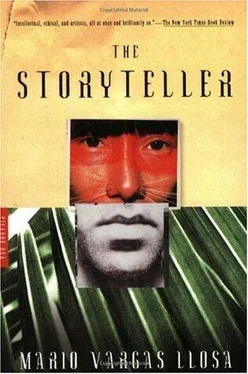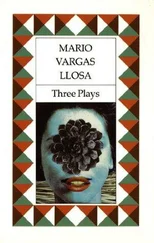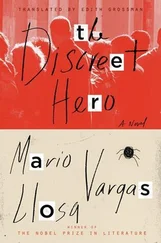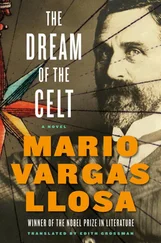No matter: I don’t need to see that photograph again. I know it by heart, millimeter by millimeter. And I’ve thought about it so much that, curiously enough, I know that the naked seated figures with their long locks of straight hair, the silhouette of the storyteller, the background of thick tree trunks, tangled branches, and feathery fronds outlined against the horizon beneath a mass of great potbellied gray clouds will be the most lasting memory of this Florentine summer. More enduring and more moving, perhaps, than the artistic and architectonic marvels of the Renaissance, the harmonious murmur of Dante’s terza rima, or the rustic ritornellos (in his case unfailingly compatible with diabolical intelligence) of Machiavelli’s prose.
I am certain that the photograph shows a Machiguenga storyteller. It is the only thing about which I have no doubts. Who could that man, declaiming before that enraptured audience, be, except that figure ancestrally entrusted with the task of arousing the curiosity, the fantasy, the memory, the appetite for dreams and fabrication of the Machiguenga people? How did Gabriele Malfatti manage to be present on that occasion, to be allowed to take photographs? Perhaps the reason for the secrecy that surrounded the storyteller of recent years — the stranger who had turned into a Machiguenga — no longer existed when the Italian visited that region. Or perhaps in these last years the situation in the Alto Urubamba had evolved so rapidly that the storytellers no longer fulfill their age-old function, have lost their authenticity and become a pantomime put on for tourists, like the ceremonies with annatto or the healings by shamans of other tribes.
But I don’t think that’s the case. Life has admittedly changed in that region, but not in any way likely to increase tourism. First came the oil wells, and with them, camps for those who were taken on as workers: many Campas, Yaminahuas, Piros, and, surely, Machiguengas. Later on, or at the same time, the drug traffic began and, like a biblical plague, spread its network of coca plantations, laboratories, and secret landing strips, with — as a logical consequence — periodic killings and vendettas between rival gangs of Colombians and Peruvians; the burning of coca crops, the police searches and wholesale roundups. And finally — or perhaps at the same time, closing the triangle of horror — terrorism and counterterrorism. Detachments of the revolutionary Sendero Luminoso movement, severely repressed in the Andes, have come down to the jungle and operate in this part of Amazonia, now periodically reconnoitered by the Army and even, it is said, bombarded by the Air Force.
What effect has all this had on the Machiguenga people? Has it hastened its dismemberment and disintegration? Do the villages that had begun to bring them together some five or six years ago still exist? These villages will, of course, have been exposed to the irreversible disruptive mechanism of this contradictory civilization, represented by the high wages paid by Shell and Petro Perú, the coffers stuffed full of dollars from the drug trade, and the risks of being drawn into the bloody wars of smugglers, guerrilleros, police, and soldiers, without having the faintest idea of what the deadly game is all about. As happened when they were invaded by the Inca armies, the explorers, the Spanish conquistadors and missionaries, the rubber and wood traders in the days of the Republic, the gold prospectors and the twentieth-century immigrants. For the Machiguengas, history marches neither forward nor backward: it goes around and around in circles, repeats itself. But even though the damage to the community has been considerable because of all this, it is likely that many of them, faced with the upheavals of the last few years, will have opted for the traditional response ensuring their survival: diaspora. Start walking. Once again. As in the most persistent of their myths.
Does my ex-friend, ex-Jew, ex-white man, and ex-Westerner, Saúl Zuratas, walk with them, taking those short steps with the whole foot planted flat on the ground, like palmipeds, so typical of all the Amazonian tribes? I have decided that it is he who is the storyteller in Malfatti’s photograph. A personal decision, since objectively I have no way of knowing. It’s true that the face of the figure standing is the most heavily shadowed — on the right side, where his birthmark was. This might be a key to identifying him. But at that distance the impression could be misleading; it might be no more than the sun’s shadow (his face is tilted in such a way that the dying light, falling from the opposite side, casts a shadow over the entire right side of men, trees, and clouds as the sun begins to set). Perhaps the most reliable clue is the shape of the silhouette. Even though he is far off, there is no doubt: that is not the build of a typical jungle Indian, who is usually squat, with short, bowed legs and a broad chest. The one who is talking has an elongated body and I would swear that his skin — he is naked from the waist up — is much lighter than that of his listeners. His hair, however, has that circular cut, like a medieval monk’s, of the Machiguengas. I have also decided that the hump on the left shoulder of the storyteller in the photograph is a parrot. Wouldn’t it be the most natural thing in the world for a storyteller to travel through the forest with a totemic parrot, companion or acolyte?
After turning the pieces of the puzzle around and around many times and shuffling them this way and that, I see they fit. They outline a more or less coherent story, as long as one sticks strictly to anecdote and does not begin pondering what Fray Luis de León called “the inherent and hidden principle of things.”
From that first journey to Quillabamba, where the farmer who was related to his mother lived, Mascarita came into contact with a world that intrigued and attracted him. What must in the beginning have been a feeling of intellectual curiosity and sympathy for the customs and conditions of life of the Machiguengas became, with time, as he got to know them better, learned their language, studied their history, and began to share their existence for longer and longer periods, a conversion, in both the cultural and the religious meaning of the word, an identification with their ways and their traditions, in which, for reasons I can intuit but not entirely understand, Saúl found spiritual sustenance, an incentive and a justification for his life, a commitment that he had not found in those other Peruvian tribes — Jewish, Christian, Marxist, etc. — among which he had lived.
This transformation must have been a very gradual one, taking place unconsciously during the years he spent studying ethnology at San Marcos. That he should have become disillusioned with his studies, that he should consider the scientific outlook of ethnologists a threat to that primitive and archaic culture (adjectives that even that early on he would not have accepted), an intrusion of destructive modern concepts, a form of corruption, is something that I can understand. The idea of an equilibrium between man and the earth, the awareness of the rape of the environment by industrial culture and today’s technology, the reevaluation of the wisdom of primitive peoples, forced either to respect their habitat or face extinction, was something that, during those years, although not yet an intellectual fashion, had already begun to take root everywhere, even in Peru. Mascarita must have lived all this with particular intensity, seeing with his own eyes the havoc wreaked by civilized peoples in the jungle, as compared with the way the Machiguengas lived in harmony with the natural world.
The decisive factor that led him to take the final step was, undoubtedly, Don Salomón’s death; he was the only person to whom Saúl was attached and to whom he felt obliged to render an account of his life. It is probable, considering how Saúl’s conduct changed in his second or third year at the university, that he had already decided that after his father’s death he would abandon everything and go to the Alto Urubamba. Up to that point, however, there is nothing extraordinary about his story. In the sixties and seventies — the years of student revolt against a consumer society — many middle-class young people left Lima, motivated partly by adventure-seeking and partly by disgust at life in the capital, and went to the jungle or the mountains, where they lived in conditions that were frequently precarious. One of the Tower of Babel programs — unfortunately ruined, for the most part, by the chronic aberrations of Alejandro Pérez’s camera — was, in fact, concerned with a group of kids from Lima who had gone off to the department of Cusco, where they survived by taking up picturesque occupations. That, like them, Mascarita should have decided to turn his back on a bourgeois future and go to Amazonia in search of adventure — a return to fundamentals, to the source — was not particularly remarkable.
Читать дальше












